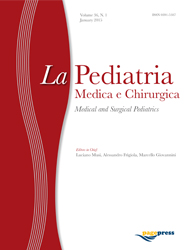Case Reports
27 June 2016
Vol. 38 No. 2 (2016)
Laparoscopic treatment of congenital choledochal cyst and hepaticojejunostomy with extracorporeal Roux-en-Y anastomosis: technical aspects and early experience with three cases

Publisher's note
All claims expressed in this article are solely those of the authors and do not necessarily represent those of their affiliated organizations, or those of the publisher, the editors and the reviewers. Any product that may be evaluated in this article or claim that may be made by its manufacturer is not guaranteed or endorsed by the publisher.
All claims expressed in this article are solely those of the authors and do not necessarily represent those of their affiliated organizations, or those of the publisher, the editors and the reviewers. Any product that may be evaluated in this article or claim that may be made by its manufacturer is not guaranteed or endorsed by the publisher.
2933
Views
1115
Downloads
785
HTML






